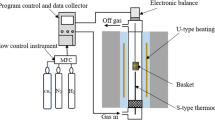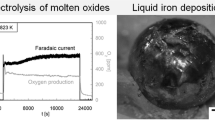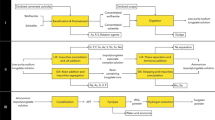Abstract
Effects of molybdenum and tungsten on carbon activity in nickel have been experimentally determined at 1000, 1100, and 1200 °C. Seventeen nickel-molybdenum and thirteen nickel-tungsten binary alloys were carburized in a flow of purified methane and hydrogen mixed gas. A sealed capsule technique was also employed for carburization of a few series of nickel-molybdenum alloys. The carbon concentration was determined either by hot extraction techniques (LECO and Coulomatic) or by weight gains of these specimens. The carbon concentration at a constant carbon activity decreases with increasing either molybdenum or tungsten concentration in nickel. The effect of tungsten on the carbon solubility in nickel is slightly larger than that of molybdenum. The experimental data were analyzed in terms of the regular solution model with two sublattices due to Hillert and Staffansson. Temperature dependence of the interaction coefficients between carbon and molybdenum or tungsten was expressed as DGMo/RT = −4.45 + 11650/T andDG W /R = 1.21 + 9010/.
Similar content being viewed by others
References
T. Murakami, S. Takeda, K. Mutsuzaki, and T. Murase:Nippon Kinzoku Gakkai Shi (J. Japan Inst. Metals), 1940, vol. 4, pp. 189–98.
W. Köster and S. Kabermann:Arch. Eisenhüttenwessen, 1955, vol. 26, pp. 627–30.
K. Löbl, H. Tůma, and M. Ciznerova:Mém. Sci. Rev. Métall., 1974, vol. 71, pp. 271–79.
A. C. Fraker and H. H. Stadelmaier:TMS-AIME, 1969, vol. 245, pp. 847–50.
M. L. Fiedler and H. H. Stadelmaier:Z. Metallkde., 1975, vol. 66, pp. 402–04.
M. Hillert and L. I. Staffansson:Acta Chem. Scand., 1970, vol. 24, pp. 3618–26.
Metals Handbook, ASM, Metals Park, OH, 1973, vol. 8, p. 319, p. 326.
R. P. Smith:TMS-AIME, 1960, vol. 218, pp. 62–64.
T. Wada, H. Wada, J. F. Elliott, and J. Chipman:Metall. Trans., 1971, vol. 2, pp. 2199–2208.
S. Takeda: Doctor of Engineering Thesis, Tokyo Institute of Technology, 1978.
A. J. Heckler and P. G. Winchell:TMS-AIME, 1963, vol. 227, pp. 732–36.
T. Nishizawa: Swedish Council Appl. Res. Rep. (4602), 1967.
B. Uhrenius:Scand. J. Met., 1973, vol. 2, pp. 177–82.
S. Ban-ya, J. F. Elliott, and J. Chipman:Metall. Trans., 1970, vol. 1, pp. 1313–20.
B. Uhrenius:Proc. Hardenabilit Concepts with Applications to Steel,TMS-AIME, Warrendale, PA, 1978, pp. 28–81.
K. Löbl and H. Tůma:Mém. Sci. Rev. Métall., 1970, vol. 67, pp. 11–16.
T. Johansson and B. Uhrenius:Metal Sci., 1978, pp. 83–94.
Author information
Authors and Affiliations
Additional information
Formerly Graduate Student, Department of Metallurgical Engineering, Tokyo Institute of Technology
Formerly Professor, Department of Metallurgical Engineering, Tokyo Institute of Technology
Rights and permissions
About this article
Cite this article
Kikuchi, M., Takeda, S., Kajihara, M. et al. Activity of carbon in nickel-rich Ni-Mo and Ni-W alloys. Metall Trans A 19, 645–650 (1988). https://doi.org/10.1007/BF02649278
Received:
Issue Date:
DOI: https://doi.org/10.1007/BF02649278




